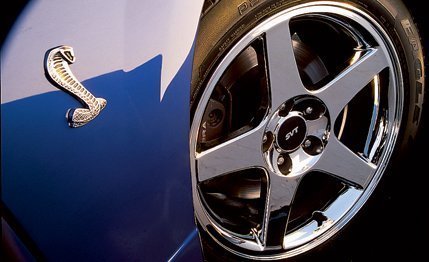Coletti likes to emphasize that the new Cobra is not a one-dimensional car. By that he means it’s no longer possible to build one-trick pony cars in a market sensitized by high-performance offerings that also provide sophisticated levels of refinement. So, although SVT may have been handicapped by the Fox platform on which the Mustang has been based since 1979, it certainly made a sincere effort to produce a civilized Cobra.
In terms of power delivery, shift quality, steering feel, and noise levels, the ’03 Mustang Cobra offers quite tolerable levels of comfort—particularly in comparison with the Cobra R, whose performance it now so closely matches. (The ’03’s 12.9-second quarter-mile at 111 mph is actually 0.1 second quicker.) The ride is still a bit too firm, however, and although that might trouble owners living in colder climates, the upside is a well-balanced ride-and-handling compromise.
Compared with the Cobra R, which we tested against the Dodge Viper GTS ACR and Chevrolet Corvette Z06 (February 2001), the new Cobra combines a less-radical ride and less grip (0.90 versus 0.99 g) with a greater sense of stability during hard cornering. At Firebird, we found we could brake late into corners, trailing off as we turned in, and the amount of rotation was controllable and confidence inspiring.
|
|
Even when drifting with all four wheels in a slide, the Cobra was receptive to messages from the brakes, throttle pedal, and wheel. In fact, the overly quick off-center steering response we recall from previous Cobras has been transformed to properly linear steering gain as you add pressure to the thick, leather-wrapped rim.
Since the supercharger installation adds about 160 pounds to the front end once you add in the Eaton blower, the cast-iron block, and the intercooler installation, one might expect the resultant weight redistribution (56.6/43.4) to produce a nose-heavy car with snappy rear-end breakaway characteristics.
But somehow that’s not translated to the road, even with that phenomenal low-end-torque potential waiting for an injudicious stab of throttle. Somehow, SVT has made the chassis tolerate the nose-heavy weight distribution and big rear-drive muscle. Tolerate it? Hey, this thing loves the track.
The ’03 Cobra isn’t too bad on the road, either. The copious torque provides effortless passing acceleration, even in the hugely overdriven sixth gear. A downshift jams slower vehicles deep into the right-side mirror with an exciting roar from the exhaust—also, it has to be said, with a food-blender-like whine from the blower.
|
|
Road trips are also made pleasant by the unique leather furniture, which has suede inserts and Cobra insignia, and by the white-face instrumentation, which is electroluminescent and very evenly lit. The usual Fox-platform ergonomics prevail, but the shifter moves smoothly, the metal-trimmed clutch and brake pedals operate with a clear sense of engagement, and the steering provides better path control than that of earlier Mustangs.
There’s a more mature look to the exterior, too. A vented hood and tidy new fascia update the front end while retaining the trademark Cobra round fog lights. Clean rocker-panel sills connect the wheel arches, and the only questionable aesthetic touch is a stubby tail spoiler that squats on the decklid like a high-level bumper. But the rear diffuser looks authentic, and the Cobra logotype is embossed in the rear bumper molding, where owners have said they want to see it. Apparently, Cobra owners want everyone to notice that their cars are Cobras and not just cooking Mustangs.
Lucky for them the identity of the 2003 Cobra is so clearly expressed in its styling and insignia.
Luckier yet, the car meets its Cobra responsibilities with lots of power and great, usable handling.
What else can we say? The 2003 Cobra strikes back. At less than 35 grand, the ’03 Cobra just about renders all those Mustang tuners obsolete. They must hate that.


Leave a Reply